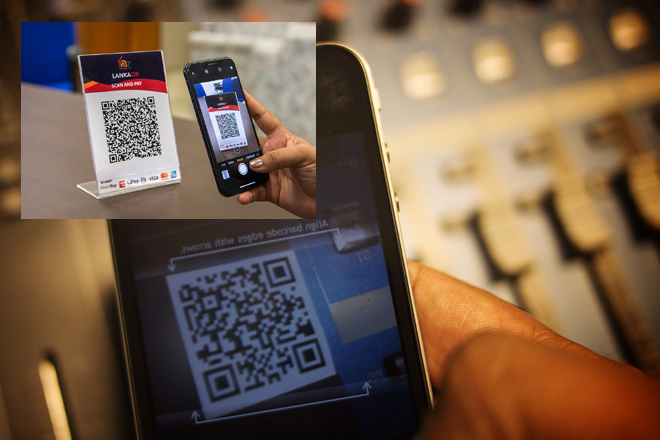Oct 12, 2018 (LBO) – Sri Lanka’s Central Bank has introduced a National Quick Response (QR) Code Standard for local currency payments with the aim of establishing a standard for payments carried out through mobile phones.
The Central Bank said this new standard called LANKAQR came into effect from this week.
All Licensed Banks, Licensed Finance Companies and Licensed operators of mobile phone-based E-money systems who offer QR code based payment solutions should conform to the new specification within 6 months.
Lanka Clear (Pvt) Ltd (LCPL) has been appointed as the main facilitating entity for the LANKAQR code based payment process and shall issue the relevant operating guidelines and branding guidelines as approved by the Central Bank.
With the new addition, customers can simply scan a LANKAQR code from the mobile payment app to make payments to any merchants accepting LANKAQR code payments.
Central Bank said customers will benefit through this as there is no hassle with cash and there will also be an instant payment notification.
Lower setup cost and transaction costs, zero maintenance cost and instant notification of payment receipt will be the benefits for merchants.
As per the new standard, no charge will be levied on the consumer for LANKAQR code initiated transactions but charges may be levied on merchants in the form of a Merchant Discount Rate (MDR).
Initially, the Central Bank may allow market forces to determine the MDR, therefore, creating a healthy competition among Merchant Acquirers, and if required, Central Bank said it may intervene in order to regularize and stabilize the MDR.
In the instance of a reversal of transactions, the total network fee should be borne by the Merchant Acquirer.
The minimum transaction limit per LANKAQR code transactions will be 10 rupees while the maximum transaction limit shall be decided by the acquirer, based on individual risk tolerance.
According to the new standard, issuers can notify the customers of the transaction status in real-time, via SMS and merchant acquirers can notify the merchants of the transaction status in real-time, via a suitable method, agreed with the merchant.
Example of distribution of a 1% MDR between all stakeholders
| Transaction Amount x in LKR |
LCPL Fee |
Issuer Fee |
Transaction Acquirer Fee |
Merchant Acquirer Fee |
| l0<=x<=100 |
0.01 |
0.25% |
0.35% (To be shared with Mobile Application Provider) |
Up to 0.40% (Determined by market forces)
- LCPL Fee |
| l00<x<=l000 |
0.10 |
| 1000<x<=5000 |
1.00 |
| 5000<x |
3.00 |
Issuer - Institutions which facilitate payments from current accounts, savings accounts, credit card accounts, mobile phone-based e-money accounts, which would be used to carry out QR code-based payments.
Acquirer - Financial institution or mobile phone-based e-money operator responsible for enrolling merchants, assigning merchant IDs, maintaining merchant records/accounts, and settling merchants. Acquirer also facilitates generation of merchant presented LANKAQR code.
Network facilitator - When the issuer and acquirer are different, the network facilitator LankaClear (Pvt) Ltd (LCPL) would be responsible for routing transactions between the respective financial institutions involved in the transaction.
Mobile Application Provider - This is the party which provides the mobile-based payment solution to facilitate transactions using LANKAQR code. This can be a third-party application provider of a financial institution or an acquiring institution.
Transaction Acquirer - The transaction acquirer is the financial institution or mobile phone-based e-money operator which facilitates the mobile application provider to acquire transactions. This party would facilitate the financial transactions via LCPL or respective payment network.

